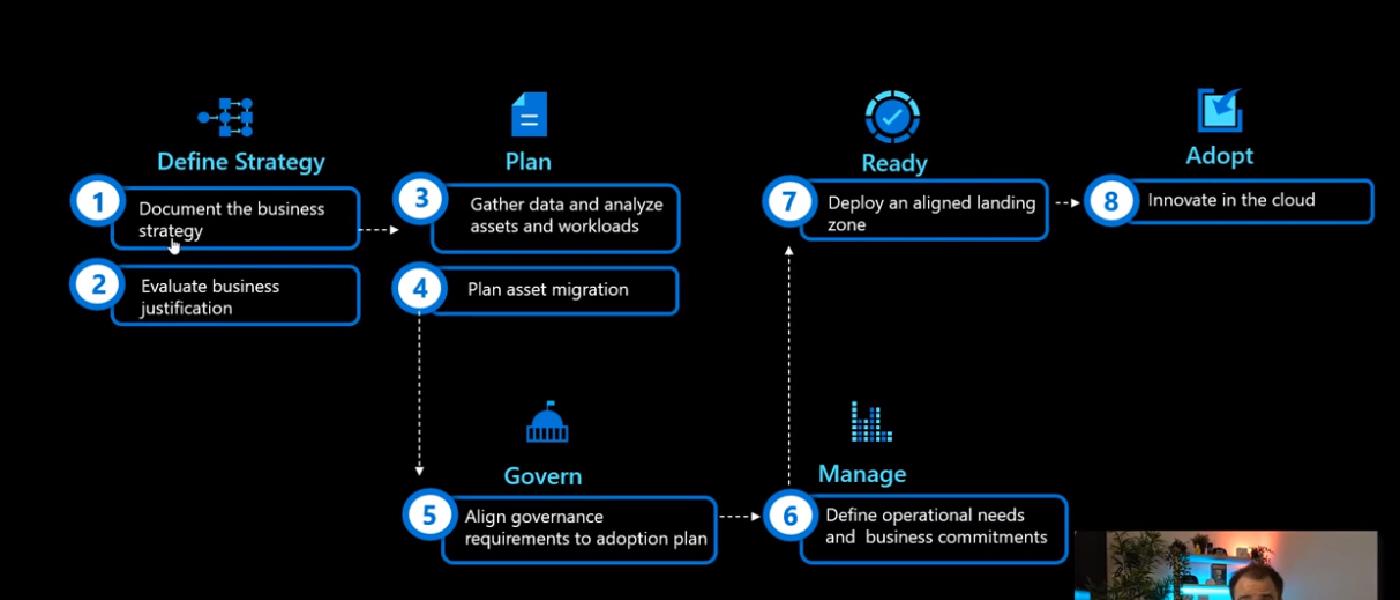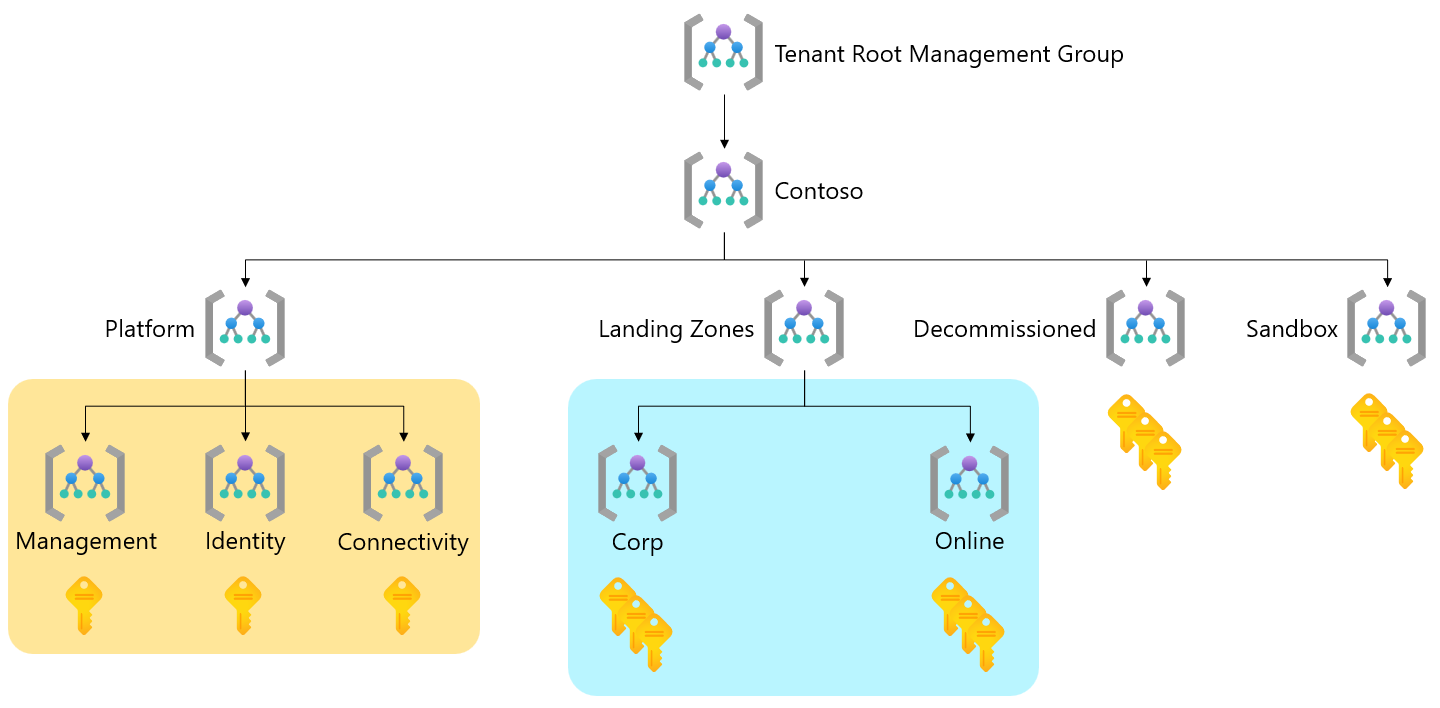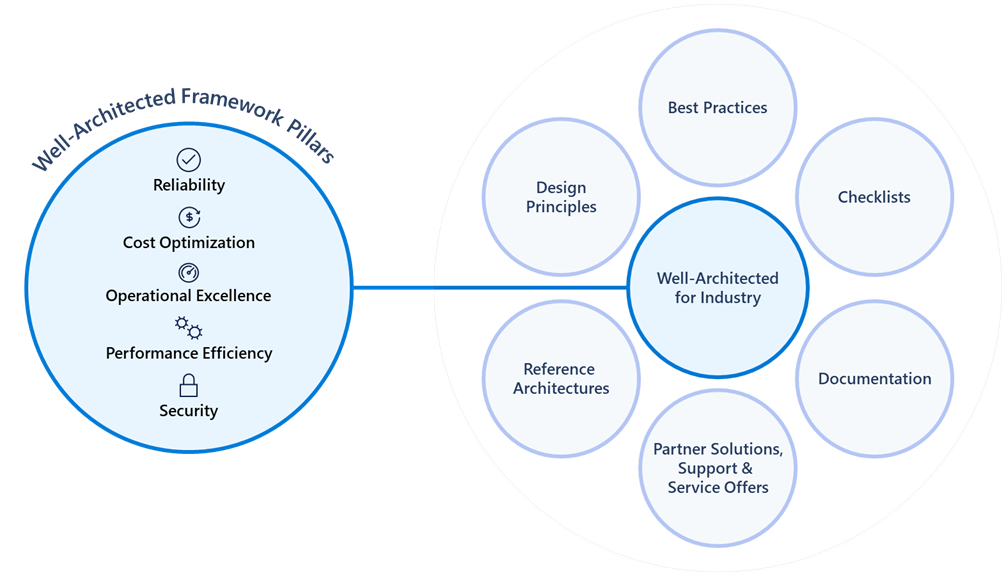Case-studies
Azure Architecture Best Practices
Posted on January 1, 1 (Last modified on May 18, 2025) • 8 min read • 1,654 wordshis is a recording of a free online event where I was presenting together with Microsoft Cloud Solution Architect, Dominik Zemp, about Azure Architecture Best Practices.

Navigating Azure: A Pragmatic Guide to Enterprise-Scale Architecture
The allure of the cloud is undeniable. Speed, agility, and innovation are the promises that draw organizations towards platforms like Microsoft Azure. However, as many a seasoned architect knows, the path to successful cloud adoption is paved with more than just technological prowess. It demands a holistic approach, one that intertwines technology with people and processes, ensuring that the journey to the cloud doesn’t lead to unforeseen complexities and costly detours. This is where frameworks like the Cloud Adoption Framework (CAF) and architectures such as Enterprise Scale Landing Zones become indispensable guides.
Recently, I came across a comprehensive discussion on Azure architecture best practices, which underscored the critical importance of a well-thought-out strategy. It’s not merely about lifting and shifting workloads; it’s about transforming how an organization operates, governs, and innovates in a cloud-native world. Let’s delve into the key principles and practices that can help technology professionals, particularly architects, navigate this landscape effectively.
The Triad of Cloud Success: Technology, People, and Processes
One of the fundamental truths highlighted is that cloud adoption is not solely a technological challenge. Around the mark, the discussion emphasizes that it necessitates a cultural shift. Traditional IT structures, often characterized by siloed teams—networking here, storage there—must evolve. The cloud demands a melting of these silos, fostering collaboration and a shared understanding across disciplines.
This leads to the concept of “T-shaped” learning. While deep expertise in specific domains remains valuable (the vertical bar of the “T”), individuals also need a broader understanding of how different components integrate and interact within the cloud ecosystem (the horizontal bar). This interdisciplinary knowledge is crucial for designing and implementing robust and efficient cloud solutions.
The challenge, then, is to balance the inherent speed and agility of the cloud with the need for control and stability. This is where established frameworks and deliberate processes play a vital role, ensuring that innovation doesn’t come at the cost of governance or security. It’s a continuous journey of improvement and adaptation.
The Cloud Adoption Framework (CAF): Your Compass for Cloud Journey
Microsoft’s Cloud Adoption Framework (CAF) emerges as a cornerstone for any organization embarking on its Azure journey. It’s more than just a collection of technical documents; it’s a comprehensive suite of proven guidance, templates, and tools designed to align technology, people, and processes. The CAF is built upon best practices and real-world learnings from countless customer implementations and Microsoft’s own product teams.
The framework spans the entire cloud adoption lifecycle, covering critical phases such as:
- Strategy: Defining business justifications and expected outcomes.
- Plan: Aligning actionable adoption plans to business outcomes.
- Ready: Preparing the cloud environment for planned changes.
- Migrate: Moving existing workloads to the cloud.
- Innovate: Developing new cloud-native solutions.
- Govern: Managing and controlling the cloud environment.
- Manage: Operating and optimizing cloud solutions.
To operationalize this guidance, the CAF offers practical tools:
- Cloud Journey Tracker: This tool allows organizations to assess their current stage in the cloud adoption process, identify potential gaps, and prioritize areas for improvement. It’s like having a GPS for your cloud migration, showing you where you are and what’s next.
- Quick Start Center: Integrated within the Azure portal, this provides contextual guidance from the CAF directly where you’re working, reducing friction and making best practices more accessible.
- Azure DevOps Generator: For the planning phase, this tool can create work items in Azure DevOps, helping teams manage tasks, track progress, and ensure that the adoption plan is systematically executed.
- Governance Benchmark: This helps evaluate an organization’s governance strategy and implementation against best practices, highlighting areas that may need strengthening to ensure compliance and control.
By leveraging these resources, organizations can effectively integrate the CAF’s value, aligning their business goals with their technology strategy to deliver faster results while maintaining the necessary control and stability.
Azure Landing Zones: Building a Solid Foundation
Once the strategic and planning groundwork is laid, the next crucial step is preparing the Azure environment itself. This is where Azure Landing Zones come into play. A landing zone is essentially a pre-configured Azure environment that provides a foundational blueprint for deploying workloads and applications. It’s about establishing a multi-subscription environment that inherently addresses critical aspects of technology implementation, governance, and security from the outset.

Landing zones offer a structured approach, providing examples and templates for various scenarios because not all solutions have the same requirements. They provide guidance on:
- Technology Implementation: This includes setting up the network topology, connectivity to on-premises systems (if needed), and organizing resources effectively within Azure.
- Governance: A key emphasis is on maintaining control without stifling agility. Landing zones facilitate the implementation of policies, ensure compliance, and enable effective resource management through tools and frameworks.
- Security: Security is a paramount concern. Landing zones provide guidance on identity and access management, network security best practices, and mechanisms for protecting resources, catering to both cloud-only and hybrid scenarios.
Think of a landing zone as preparing the plot of land before building a house. You ensure the utilities are connected, the boundaries are defined, and the ground is stable, so that when you start building, you can do so efficiently and securely.
Enterprise Scale Architecture: Designing for Complexity and Growth
For larger organizations or those with complex requirements, the Enterprise Scale Architecture offers a robust approach and reference implementation for building Azure landing zones at scale. It’s built upon a set of well-defined design principles and provides comprehensive recommendations across various critical design areas.
Core Design Principles of Enterprise Scale
The Enterprise Scale architecture is guided by several key principles that shape its design and implementation:
- Subscription Democratization:
- Policy-Driven Governance:
- Single Control and Management Plane:
- Azure-Native Design and Platform Roadmap Alignment:
These principles, when applied consistently, result in an Azure environment that is scalable, governable, secure, and agile.
The Eight Critical Design Areas of Enterprise Scale
Enterprise Scale provides detailed recommendations across eight critical design areas, ensuring a comprehensive and well-rounded platform architecture:
- Enterprise Enrollment and Azure Active Directory Tenant:
- Identity and Access Management (IAM):
- Resource Organization:
- Network Topology and Connectivity:
- Management and Monitoring:
- Business Continuity and Disaster Recovery (BCDR):
- Security:
- Platform Automation and DevOps:
The video also provides a demonstration of deploying the Enterprise Scale architecture using the Azure portal and discusses the availability of Terraform modules for those who prefer an Infrastructure-as-Code approach from the start.
AC Ops: Keeping the Platform Evergreen
A noteworthy mention is AC Ops, described as a toolset for keeping the Azure platform up to date. Importantly, it’s not mandatory and can be adopted by any Azure customer, even those not using the full Enterprise Scale implementation.
AC Ops leverages native toolsets like Azure PowerShell and JSON ARM templates, allowing the CCoE or platform team to use their preferred tooling to apply changes and updates. It promotes a consistent experience by maintaining the desired state of the Azure environment in a Git repository, essentially providing a primitive CI/CD pipeline for Azure platform resources such as management groups and subscriptions. This allows organizations to bring their own ARM templates and integrates well with the overall Enterprise Scale architecture.
The Azure Well-Architected Framework: Optimizing Your Workloads
Complementing the CAF and Landing Zone concepts is the Azure Well-Architected Framework (WAF). While CAF guides the overall adoption journey and Landing Zones provide the foundational environment, the WAF offers guiding tenets to improve the quality of individual applications and workloads running on Azure. It helps evaluate workloads against Azure best practices and provides actionable guidance for improvement.

The WAF is built on five pillars of architectural excellence:
- Cost Optimization: Focuses on managing costs effectively, starting small, and leveraging Azure’s platform capabilities and pricing models (e.g., reservations, spot instances) to achieve the best value.
- Operational Excellence: Emphasizes running and monitoring systems to deliver business value and continually improving supporting processes and procedures. This often involves reliable and automated deployments using CI/CD pipelines.
- Performance Efficiency: Deals with the ability of a system to adapt to changes in load. This includes scaling applications (both vertically and horizontally) to meet business demands efficiently.
- Reliability: Covers designing systems that are resilient to failures and can recover quickly. This involves utilizing Azure’s high-availability features (like availability zones and regions) and building fault tolerance into applications.
- Security: Stresses protecting applications and data through1 a defense-in-depth approach, integrating platform security features and implementing robust application-level security measures throughout the entire lifecycle.
The Well-Architected Framework is not a one-time checklist but rather a continuous process of review and improvement. It provides assessment tools and recommendations that help architects and development teams ensure their solutions are optimized across these five critical dimensions. It integrates naturally with the CAF’s “adopt” phase and ensures that workloads deployed into Azure Landing Zones are designed for success.
Closing Reflections: The Journey to Cloud Maturity
The journey to cloud maturity is an ongoing process, not a destination. Frameworks like the Cloud Adoption Framework, architectures like Enterprise Scale Landing Zones, and principles from the Well-Architected Framework provide invaluable maps and compasses. They bring structure to complexity, enabling organizations to harness the power of Azure effectively and sustainably.
The key takeaway is the emphasis on a holistic, principled approach. It’s about understanding that technology choices have profound implications for people and processes, and vice-versa. By embracing concepts like subscription democratization, policy-driven governance, and native Azure design, architects can build platforms that are not only technically sound but also empower innovation and agility across the enterprise.
The shift to the cloud is as much about transforming culture and operational models as it is about adopting new technologies. The guidance and tools discussed provide a robust foundation for this transformation, helping organizations to avoid common pitfalls and accelerate their journey towards becoming truly cloud-native. As architects and technology leaders, our role is to champion these principles, adapt them to our unique contexts, and guide our organizations towards a future where the cloud is a powerful enabler of business success.